Energy Modelling and Automated Calibrations of Ancient Building Simulations: A Case Study of a School in the Northwest of Spain
Abstract
:1. Introduction
2. Description of the Experimental System
2.1. Building Description
2.2. Temperature Monitoring
3. Simulation Methodology
3.1. Simulation Software
3.2. Model Description
3.3. Weather File
3.4. Simulation
Operational Conditions
3.5. Calibration
- is the simulated indoor air temperature of the zone;
- is the registered real temperature;
- is the average registered real temperature;
- n is the number of data.
4. Results and Discussion
4.1. Calibration Results
4.2. Model Validation
5. Conclusions
Acknowledgments
Author Contributions
Conflicts of Interest
References
- Recast, E.P.B.D. Directive 2010/31/EU of the European Parliament and of the Council of 19 May 2010 on the Energy Performance of Buildings; Official Journal of the European Union (OJ): Brussels, Belgium, 2010. [Google Scholar]
- Parliament, E. Directive 2012/27/EU of the European Parliament and of the Council of 25 October 2012 on Energy Efficiency, Amending DIRECTIVES 2009/125/EC and 2010/30/EU and Repealing Directives 2004/8/EC and 2006/32/EC; European Commission: Brussels, Belgium, 2012. [Google Scholar]
- European Commsion. Available online: https://ec.europa.eu/energy/en/topics/energy-efficiency/buildings (accessed on 16 May 2017).
- Martinez-Molina, A.; Boarin, P.; Tort-Ausina, I.; Vivancos, J.-L. Post-occupancy evaluation of a historic primary school in Spain: Comparing PMV, TSV and PD for teachers’ and pupils’ thermal comfort. Build. Environ. 2017, 117, 248–259. [Google Scholar] [CrossRef]
- Nolte, I.; Strong, D. Europe’s Buildings under the Microscope; Buildings Performance Institute Europe (BPIE): Bruxelles, Belgium, 2011. [Google Scholar]
- Pérez-Lombard, L.; Ortiz, J.; Pout, C. A review on buildings energy consumption information. Energy Build. 2008, 40, 394–398. [Google Scholar] [CrossRef]
- Lam, J.C. Energy analysis of commercial buildings in subtropical climates. Build. Environ. 2000, 35, 19–26. [Google Scholar] [CrossRef]
- Ma, Z.; Cooper, P.; Daly, D.; Ledo, L. Existing building retrofits: Methodology and state-of-the-art. Energy Build. 2012, 55, 889–902. [Google Scholar] [CrossRef]
- Salvalai, G.; Malighetti, L.E.; Luchini, L.; Girola, S. Analysis of different energy conservation strategies on existing school buildings in a Pre-Alpine Region. Energy Build. 2017, 145, 92–106. [Google Scholar] [CrossRef]
- Sekki, T.; Airaksinen, M.; Saari, A. Effect of energy measures on the values of energy efficiency indicators in Finnish daycare and school buildings. Energy Build. 2017, 139, 124–132. [Google Scholar] [CrossRef]
- Congedo, P.; D’Agostino, D.; Baglivo, C.; Tornese, G.; Zacà, I. Efficient solutions and cost-optimal analysis for existing school buildings. Energies 2016, 9, 851. [Google Scholar] [CrossRef]
- Pisello, A.; Bobker, M.; Cotana, F. A building energy efficiency optimization method by evaluating the effective thermal zones occupancy. Energies 2012, 5, 5257–5278. [Google Scholar] [CrossRef]
- Crawley, D.B.; Hand, J.W.; Kummert, M.; Griffith, B.T. Contrasting the capabilities of building energy performance simulation programs. Build. Environ. 2008, 43, 661–673. [Google Scholar] [CrossRef]
- Klein, S. TRNSYS 17—A Transient System Simulation Program User Manual; University of Wisconsin-Madison, Solar Energy Laboratory: Madison, WI, USA, 2012. [Google Scholar]
- Ciulla, G.; Lo Brano, V.; D’Amico, A. Modelling relationship among energy demand, climate and office building features: A cluster analysis at European level. Appl. Energy 2016, 183, 1021–1034. [Google Scholar] [CrossRef]
- Martínez-Ibernón, A.; Aparicio-Fernández, C.; Royo-Pastor, R.; Vivancos, J.L. Temperature and humidity transient simulation and validation in a measured house without a HVAC system. Energy Build. 2016, 131, 54–62. [Google Scholar] [CrossRef]
- Cacabelos, A.; Eguía, P.; Míguez, J.L.; Granada, E.; Arce, M.E. Calibrated simulation of a public library HVAC system with a ground-source heat pump and a radiant floor using TRNSYS and GenOpt. Energy Build. 2015, 108, 114–126. [Google Scholar] [CrossRef]
- Rey, G.; Ulloa, C.; Míguez, J.; Cacabelos, A. Suitability assessment of an ICE-based micro-CCHP unit in different Spanish climatic zones: Application of an experimental model in transient simulation. Energies 2016, 9, 969. [Google Scholar] [CrossRef]
- Kim, Y.-J.; Park, C.-S. Stepwise deterministic and stochastic calibration of an energy simulation model for an existing building. Energy Build. 2016, 133, 455–468. [Google Scholar] [CrossRef]
- Chae, Y.; Lee, Y.; Longinott, D. Assessment of retrofitting measures for a large historic research facility using a building energy simulation model. Energies 2016, 9, 466. [Google Scholar] [CrossRef]
- Fabrizio, E.; Monetti, V. Methodologies and advancements in the calibration of building energy models. Energies 2015, 8, 2548–2574. [Google Scholar] [CrossRef]
- Guideline 14-2002, Measurement of Energy and Demand Savings; American Society of Heating, Ventilating, and Air Conditioning Engineers: Atlanta, Georgia, 2002.
- Cacabelos, A.; Eguía, P.; Febrero, L.; Granada, E. Development of a new multi-stage building energy model calibration methodology and validation in a public library. Energy Build. 2017, 146, 182–199. [Google Scholar] [CrossRef]
- ENGINENCY. A Holistic System for Building Inspection and Energy Efficiency Management. Available online: http://www.enginency-project.eu/ (accessed on 16 May 2017).
- MeteoGalicia. Available online: http://www.meteogalicia.gal/web/index.action (accessed on 16 May 2017).
- ISO. Ergonomics of the Thermal Environment—Analytical Determination and Interpretation of Thermal Comfort Using Calculation of the PMV and PPD Indices and Local Thermal Comfort Criteria; ISO: Geneva, Sweden, 2005. [Google Scholar]
- Mors, S.T.; Hensen, J.L.M.; Loomans, M.G.L.C.; Boerstra, A.C. Adaptive thermal comfort in primary school classrooms: Creating and validating PMV-based comfort charts. Build. Environ. 2011, 46, 2454–2461. [Google Scholar] [CrossRef]
- Teli, D.; Jentsch, M.F.; James, P.A.B. Naturally ventilated classrooms: An assessment of existing comfort models for predicting the thermal sensation and preference of primary school children. Energy Build. 2012, 53, 166–182. [Google Scholar] [CrossRef]
- Almeida, R.M.S.F.; Ramos, N.M.M.; de Freitas, V.P. Thermal comfort models and pupils’ perception in free-running school buildings of a mild climate country. Energy Build. 2016, 111, 64–75. [Google Scholar] [CrossRef]
- Havenith, G. Metabolic rate and clothing insulation data of children and adolescents during various school activities. Ergonomics 2007, 50, 1689–1701. [Google Scholar] [CrossRef] [PubMed]
- IDAE. Guía Técnica de Instalaciones de Climatización con Equipos Autónomos. Available online: http://www.idae.es/uploads/documentos/documentos_17_Guia_tecnica_instalaciones_de_climatizacion_con_equipos_autonomos_f9d4199a.pdf (accessed on 13 June 2017).
- ASHRAE. ASHRAE Handbook of Fundamentals 1989, Chapter 22: Ventilation and Infiltration; ASHRAE: New York, NY, USA, 1989. [Google Scholar]
- GENOPT. Generic Optimization Program. Available online: http://simulationresearch.lbl.gov/GO/ (accessed on 13 June 2017).
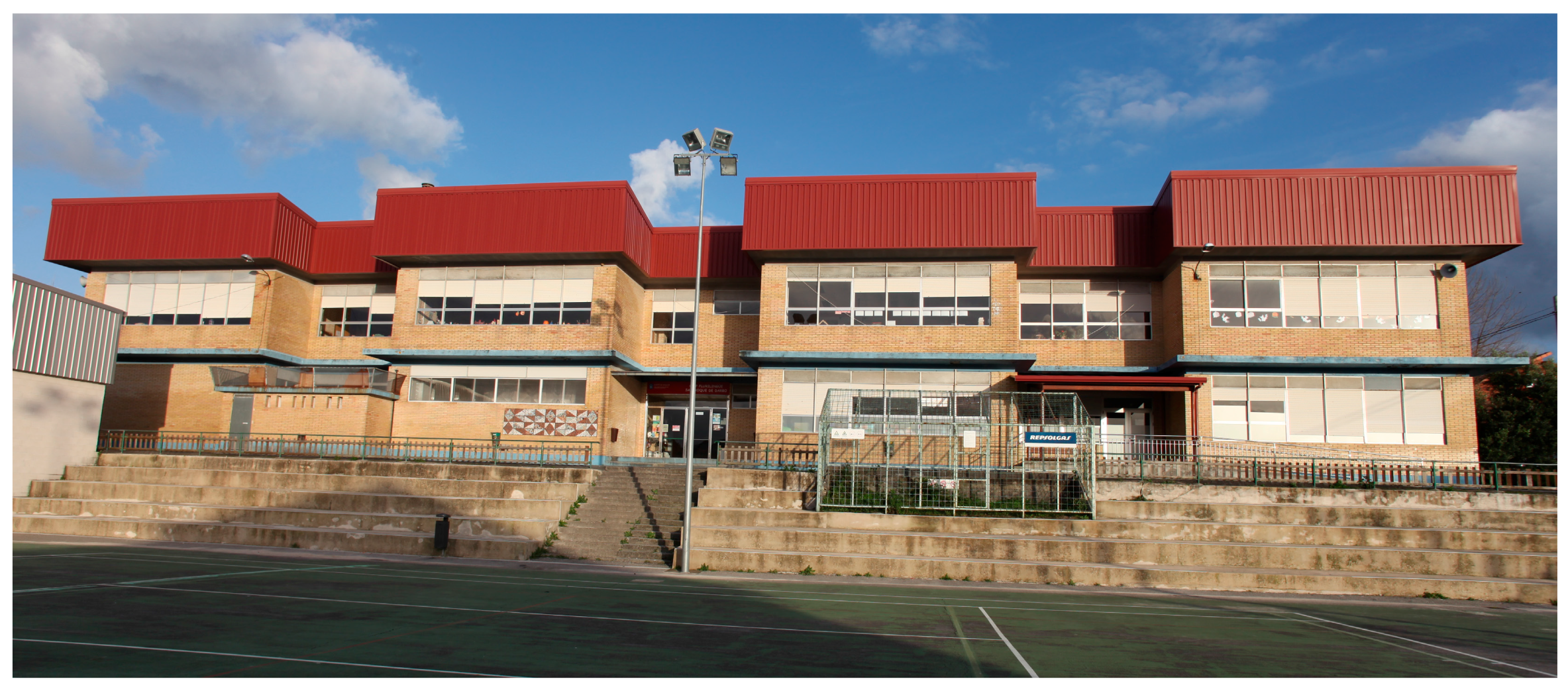


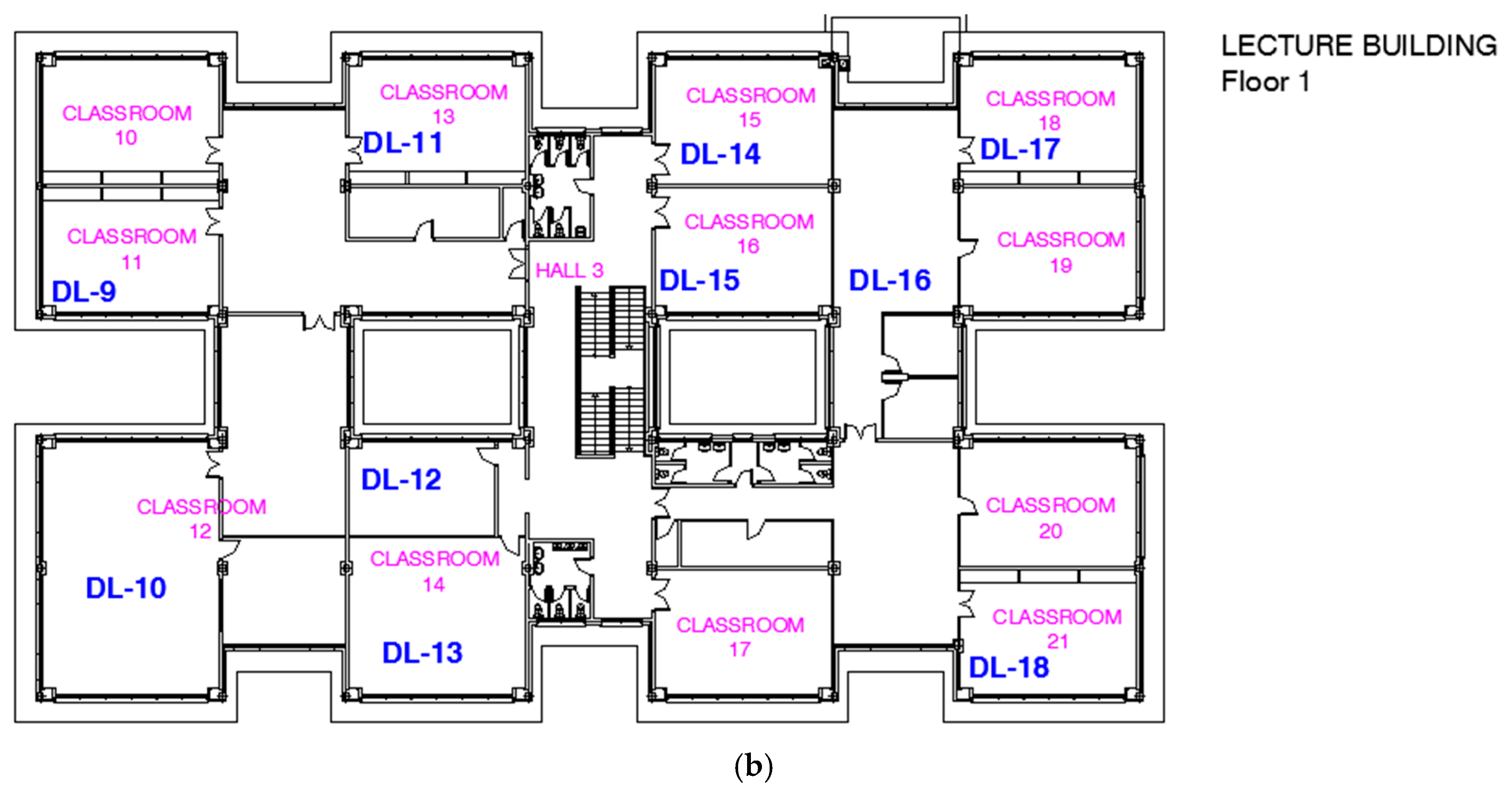

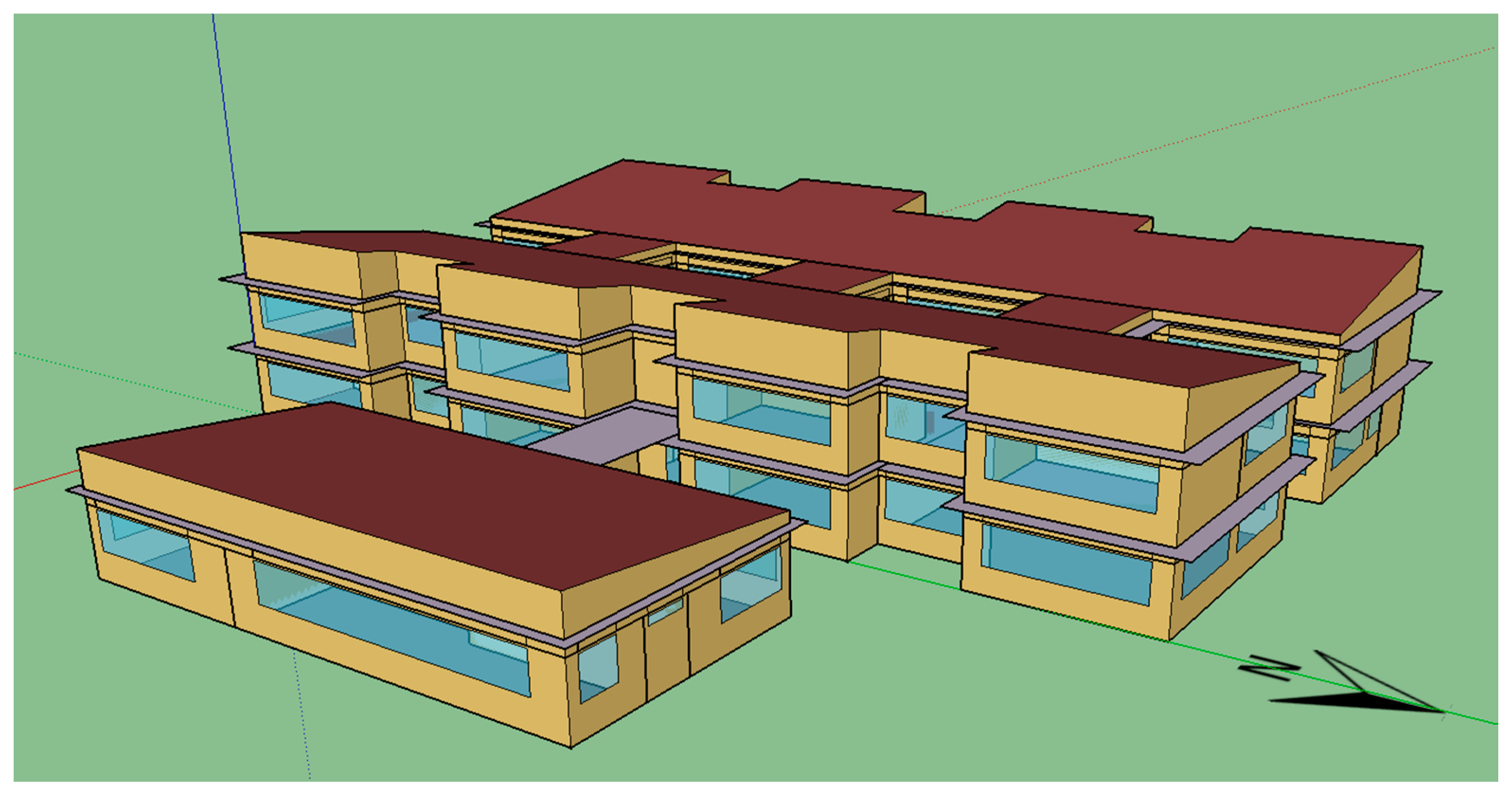
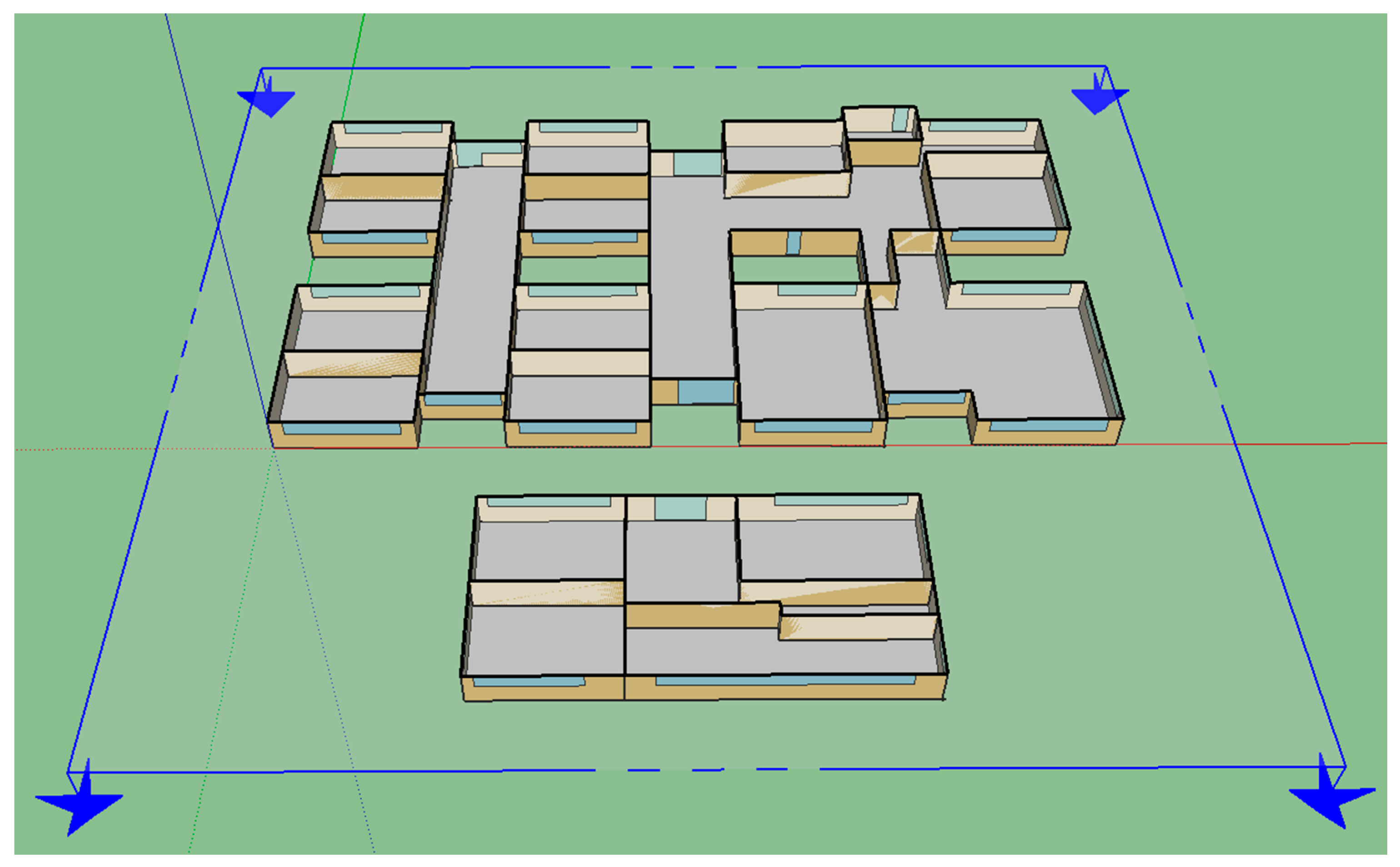




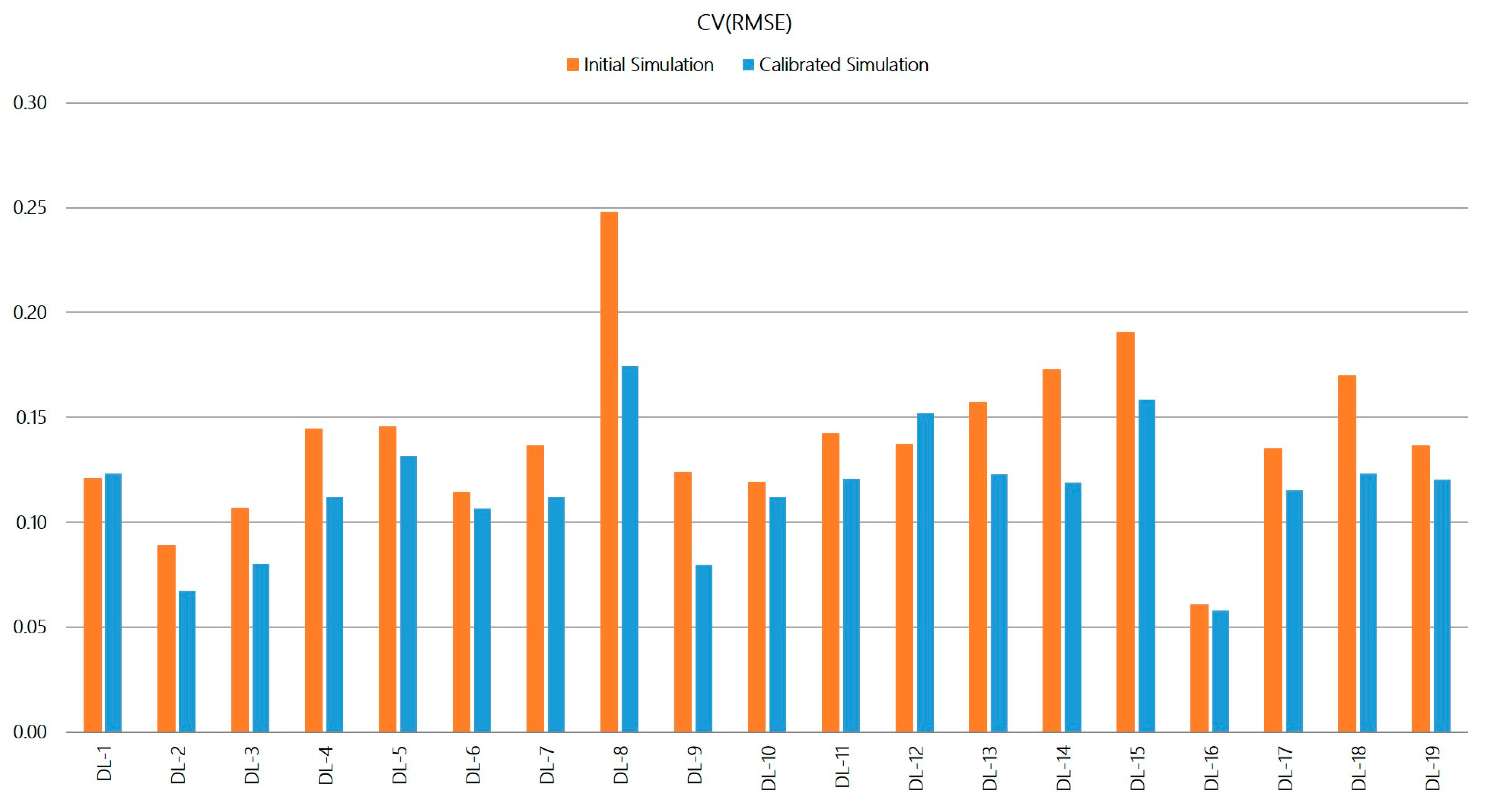
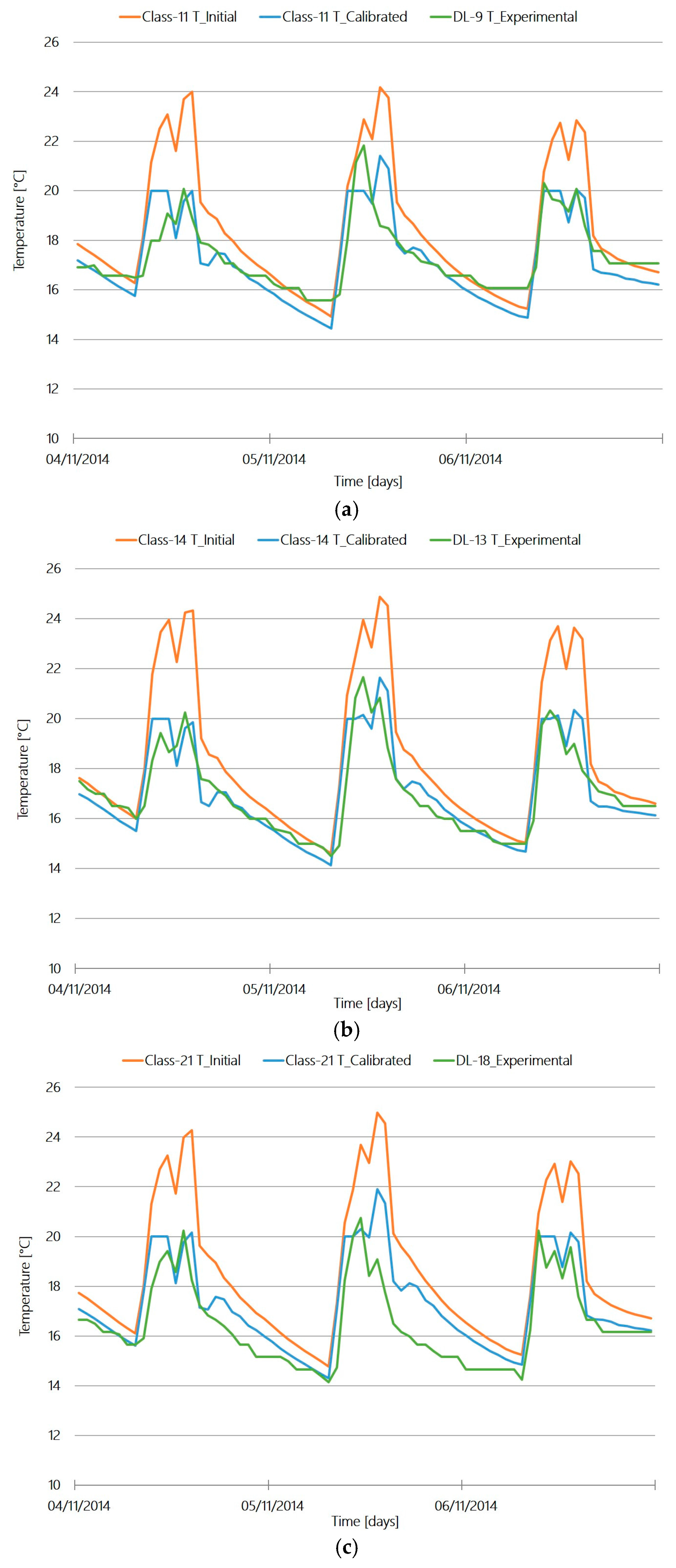
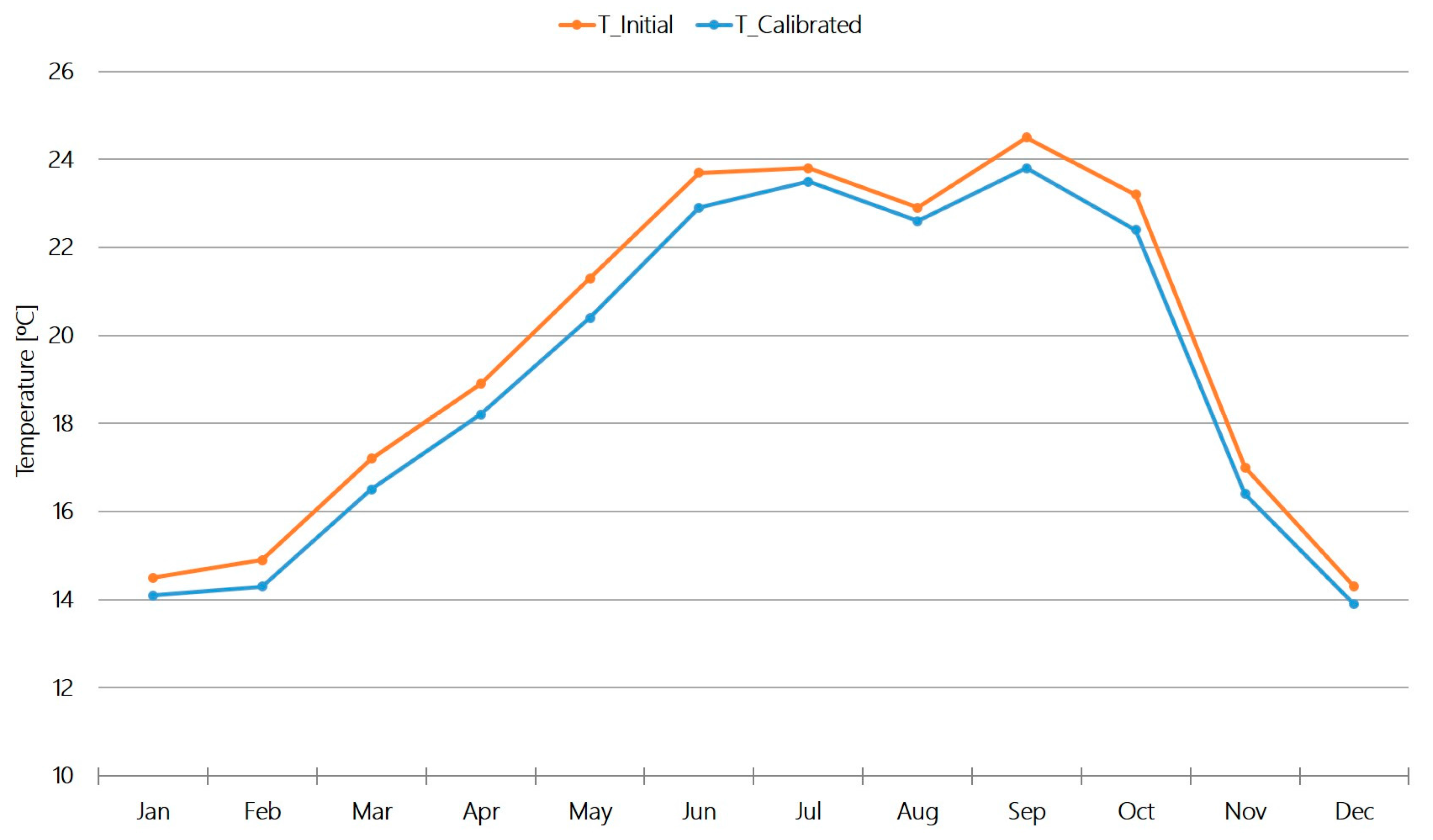
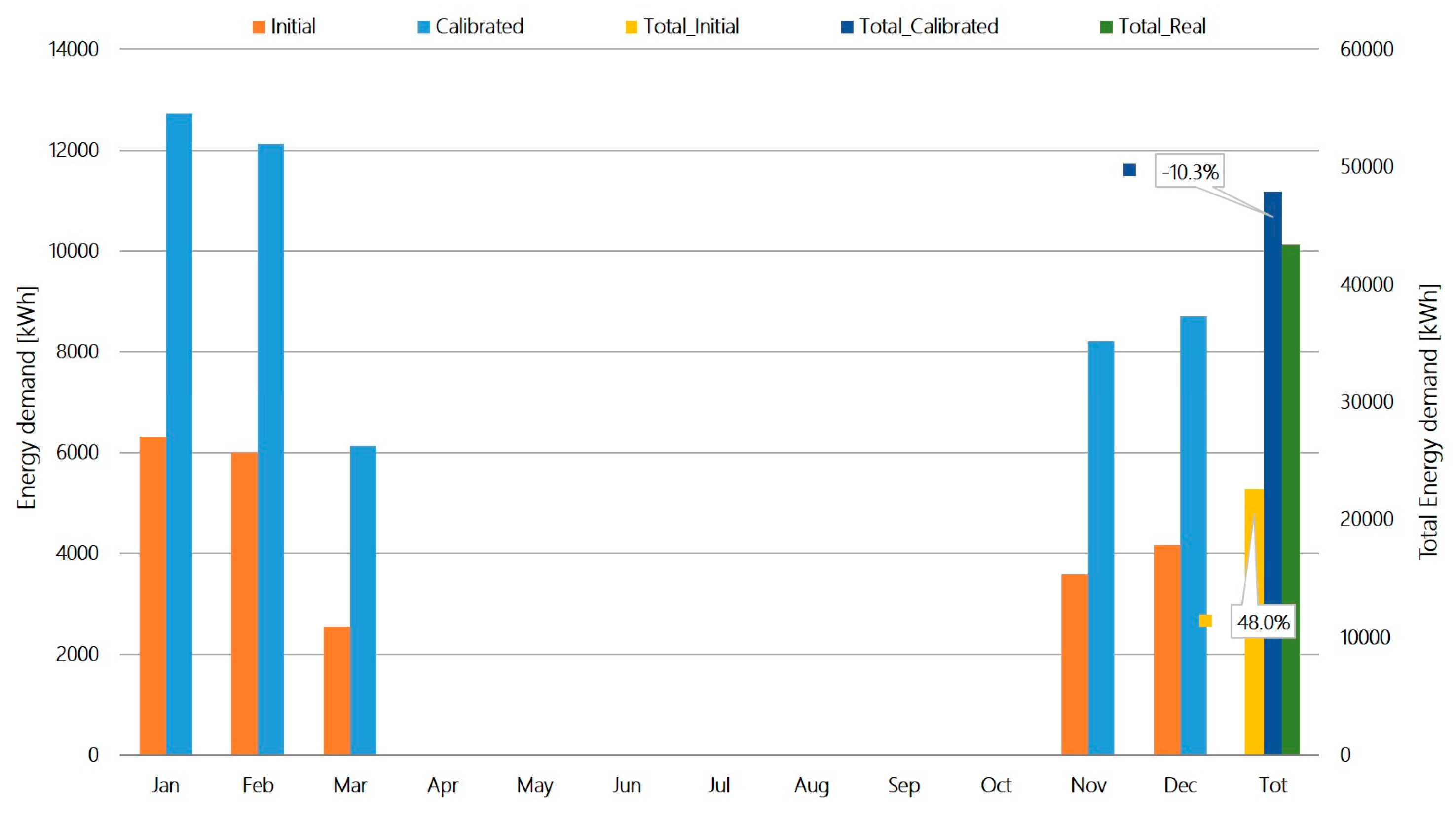
| Characteristics | Temperature Sensor | Humidity Sensor |
|---|---|---|
| Resolution | 0.1 °C | 0.1% RH (relative humidity) |
| Accuracy | ±0.5 °C | ±2.5% RH (+5% to +95% RH) |
| Manufacturer: Testo; Model: 625 | ||
| Construction | Total Thickness [m] | Total U-Value [W/m2·K] | Material | Thickness [m] | Conductivity [W/m·K] | Thermal Resistance [m2·K/W] |
|---|---|---|---|---|---|---|
| Façade | 0.21 | 3.18 | Brick fired clay ½ foot | 0.10 | 0.667 | - |
| Air chamber | - | - | 0.035 | |||
| Brick fired clay ½ foot | 0.10 | 0.667 | - | |||
| Blind box | 0.04 | 4.45 | Plywood | 0.04 | 0.178 | - |
| Brick lintel | 0.22 | 3.03 | Brick fired clay ½ foot | 0.22 | 0.667 | - |
| Concrete lintel | 0.62 | 3.71 | Reinforced concrete | 0.62 | 2.300 | - |
| Roof | 0.08 | 6.73 | Asbestos cement board | 0.01 | 0.470 | - |
| Metal sheet | 0.07 | 0.55 | - | |||
| Horizontal partition | 0.28 | 2.87 | Mortar light aggregate | 0.03 | 0.410 | - |
| Unidirectional slab ceramic | 0.25 | 0.908 | - | |||
| Vertical partition | 0.10 | 6.67 | Brick fired clay ½ foot | 0.10 | 0.667 | - |
| Slab | 0.28 | 2.87 | Mortar light aggregate | 0.03 | 0.410 | - |
| Unidirectional slab ceramic | 0.25 | 0.908 | - |
| Buildings | Layers (-) | U-Value (W/m2·K) | g-Value (%) | Area Frame/Window (%) |
|---|---|---|---|---|
| Window glass | Simple (6 mm) | 5.96 | 0.850 | - |
| Window frame | - | 5.70 | - | 15 |
| Parameter | Description |
|---|---|
| Infiltration 1 | Infiltrations below deck in both buildings |
| Infiltration 2 | Infiltrations in the false ceilings |
| Infiltration 3 | Infiltrations in the classrooms |
| Infiltration 4 | Infiltrations in zones in the Administrative Building |
| Infiltration 5 | Infiltrations in the halls of both buildings |
| Parameter | Calibrated Value |
|---|---|
| Infiltration 1 | 0.2 |
| Infiltration 2 | 0.2 |
| Infiltration 3 | 10 |
| Infiltration 4 | 9.3 |
| Infiltration 5 | 5 |
| Error | Initial Simulation | Calibrated Simulation | Reduction |
|---|---|---|---|
| NMBE | 6.82% | 2.73% | 59.97% |
| CV(RMSE) | 13.93% | 11.52% | 17.27% |
© 2017 by the authors. Licensee MDPI, Basel, Switzerland. This article is an open access article distributed under the terms and conditions of the Creative Commons Attribution (CC BY) license (http://creativecommons.org/licenses/by/4.0/).
Share and Cite
Ogando, A.; Cid, N.; Fernández, M. Energy Modelling and Automated Calibrations of Ancient Building Simulations: A Case Study of a School in the Northwest of Spain. Energies 2017, 10, 807. https://doi.org/10.3390/en10060807
Ogando A, Cid N, Fernández M. Energy Modelling and Automated Calibrations of Ancient Building Simulations: A Case Study of a School in the Northwest of Spain. Energies. 2017; 10(6):807. https://doi.org/10.3390/en10060807
Chicago/Turabian StyleOgando, Ana, Natalia Cid, and Marta Fernández. 2017. "Energy Modelling and Automated Calibrations of Ancient Building Simulations: A Case Study of a School in the Northwest of Spain" Energies 10, no. 6: 807. https://doi.org/10.3390/en10060807
APA StyleOgando, A., Cid, N., & Fernández, M. (2017). Energy Modelling and Automated Calibrations of Ancient Building Simulations: A Case Study of a School in the Northwest of Spain. Energies, 10(6), 807. https://doi.org/10.3390/en10060807





